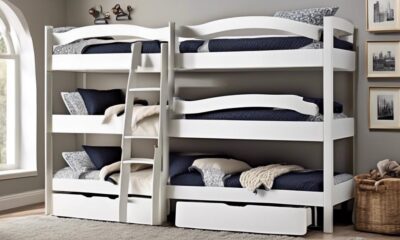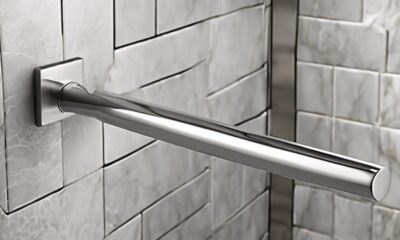Appliances
What Ceiling Fan for Garage
2025
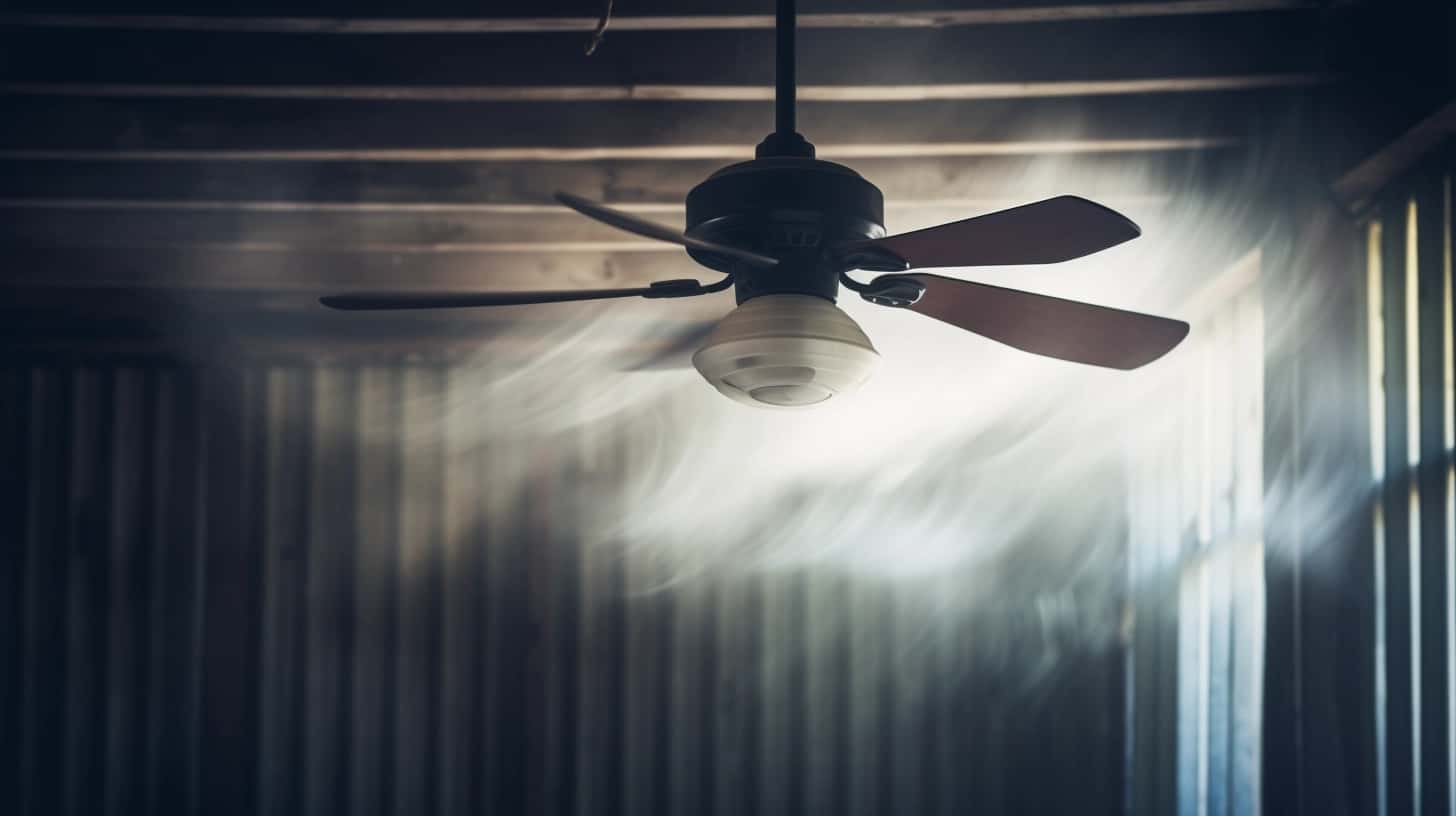
When selecting a ceiling fan for your garage, we recognize the significance of discovering the perfect match.
For instance, imagine a scenario where you spend hours working in your garage during the hot summer months. You need a fan that not only provides a cool breeze but also effectively circulates the air, allowing you to work comfortably.
In this comprehensive guide, we will explore various factors to consider when selecting the perfect ceiling fan for your garage. From size considerations and airflow capacity to energy efficiency and noise level, we will provide you with valuable insights to help you make an informed decision.

So, let’s dive in and find the ideal ceiling fan that will enhance your garage experience.
Key Takeaways
- Consider the dimensions and airflow requirements of the garage when choosing a ceiling fan
- Select the appropriate fan size based on the square footage of the garage
- Look for energy-efficient fans with features like variable speed settings and timers to reduce energy consumption
- Compare noise levels and opt for fans with high-quality motors and aerodynamic blades for quiet operation
Size Considerations
When considering the size of a ceiling fan for your garage, it’s important to take into account the dimensions of the space and the airflow requirements for optimal ventilation. The airflow requirements refer to the amount of air that needs to be circulated in the garage to maintain a comfortable and conducive environment. Size restrictions may also come into play, as the garage may have limited space available for installing a ceiling fan.
To determine the appropriate size of a ceiling fan for your garage, you need to consider the square footage of the space. Generally, larger garages require larger fans to effectively circulate air. As a rule of thumb, for garages up to 144 square feet, a fan with a blade span of 42-48 inches should suffice. For garages between 144-225 square feet, a fan with a blade span of 52 inches is recommended. For larger garages, a fan with a blade span of 60 inches or more may be necessary to ensure adequate airflow.
In addition to the square footage, you should also consider the height of the ceiling. For ceilings lower than 8 feet, a low-profile or hugger ceiling fan is ideal to avoid any clearance issues. Ceilings higher than 8 feet can accommodate standard ceiling fans.
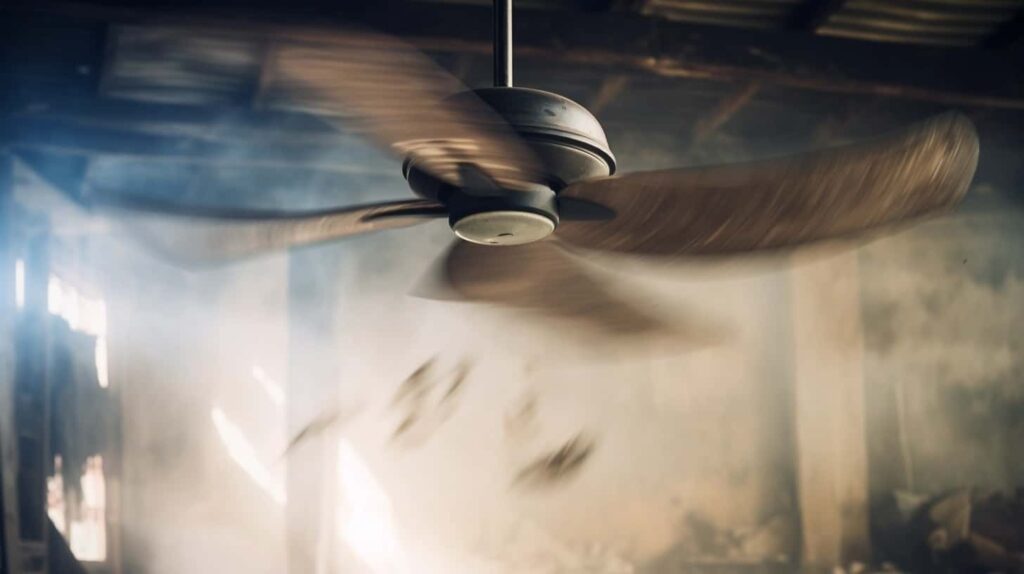
Airflow Capacity
When considering the airflow capacity of a ceiling fan for your garage, there are several key points to keep in mind.
First, airflow efficiency is crucial in determining how effectively the fan can circulate air in the space.
Second, the motor power of the fan is important as it dictates the strength and speed at which the blades rotate.
Lastly, the blade design plays a significant role in directing airflow and ensuring optimal cooling or ventilation.
Considering these points will help you choose a ceiling fan with the right airflow capacity for your garage.
Airflow Efficiency
To ensure optimal airflow efficiency in your garage, consider installing a ceiling fan designed specifically for high-capacity air circulation. When it comes to airflow efficiency, two key factors to consider are blade efficiency and energy-saving features.
Blade efficiency refers to the ability of the fan blades to move air effectively while minimizing energy consumption. Look for fans with aerodynamically designed blades that are optimized for maximum airflow.
Additionally, fans with energy-saving features such as variable speed settings and programmable timers can help reduce energy consumption and lower utility bills. These features allow you to adjust the fan’s speed and operating time according to your specific needs, ensuring that you get the right amount of airflow while minimizing energy waste.
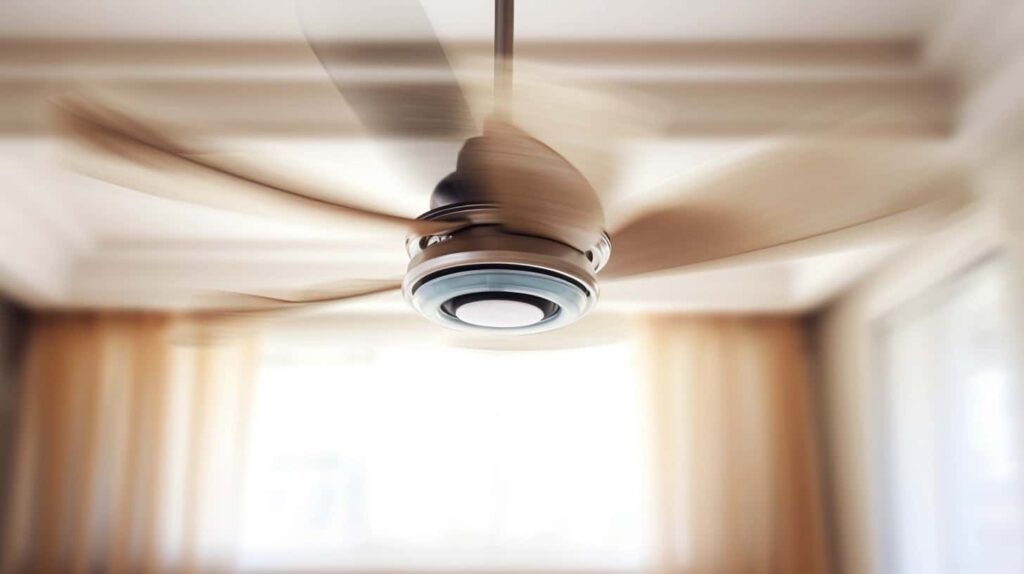
Motor Power
Now let’s explore the crucial aspect of motor power, also known as airflow capacity, in selecting the ideal ceiling fan for your garage. The motor power of a ceiling fan determines its ability to move air effectively, ensuring proper ventilation in your garage. When considering motor power, it is important to also take into account the blade material and power efficiency of the fan.
The blade material plays a significant role in determining the fan’s performance. Generally, fan blades are made from materials such as wood, metal, or plastic. Each material has its own advantages and disadvantages in terms of durability, noise level, and airflow efficiency. Plastic blades are lightweight and affordable, but may not be as durable as metal or wood blades. Metal blades are more robust and can provide better airflow, but they may generate more noise. Wood blades offer a stylish and classic look, but they require regular maintenance to prevent warping and cracking.
In addition to blade material, power efficiency is another crucial factor to consider. A fan with high power efficiency can effectively move air while consuming less energy, resulting in lower electricity bills. Look for fans with energy-efficient motors and features such as variable speed settings and timers, which allow you to adjust the fan’s speed and running time according to your needs.
To help you make an informed decision, here’s a table comparing different ceiling fan models based on their motor power, blade material, and power efficiency:
| Ceiling Fan Model | Motor Power | Blade Material | Power Efficiency |
|---|---|---|---|
| Model A | 75W | Plastic | High |
| Model B | 100W | Metal | Medium |
| Model C | 60W | Wood | Low |
Consider your garage size, ventilation needs, and budget when selecting a ceiling fan. By choosing a fan with the right motor power, blade material, and power efficiency, you can ensure optimal airflow and comfort in your garage while keeping energy costs in check.
Blade Design
Blade design, also known as airflow capacity, is a critical factor to consider when selecting a ceiling fan for your garage.
The shape of the blades determines how efficiently the fan can move air.
The most common blade shapes are flat, curved, and twisted.
Flat blades are ideal for maximizing airflow in a single direction, making them suitable for garages with a specific airflow requirement.
Curved blades, on the other hand, are designed to generate more airflow, but in a broader direction. This makes them suitable for garages that require air circulation in multiple directions.
Twisted blades combine the benefits of both flat and curved blades, providing a balanced airflow in all directions.
When choosing a ceiling fan for your garage, consider the airflow direction you need and select a blade design that meets your requirements.
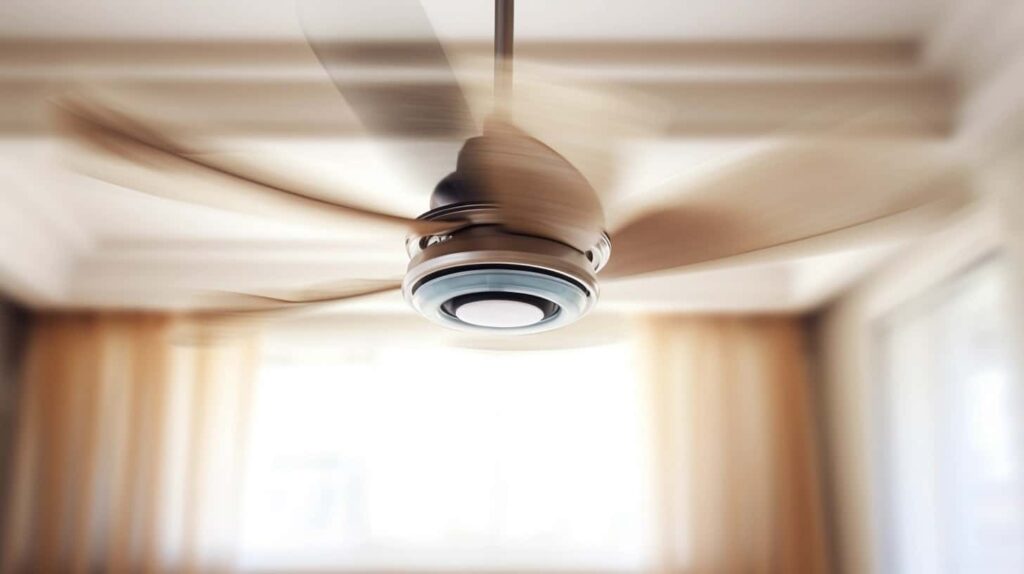
Energy Efficiency
An energy-efficient ceiling fan in the garage helps to reduce electricity consumption and increase cost savings. When looking for an energy-efficient ceiling fan, there are a few key factors to consider:
- Power Consumption: Look for a ceiling fan with a low power consumption rating. This means that the fan uses less electricity to operate, resulting in lower energy bills. Energy-efficient fans often come with an Energy Star certification, indicating that they meet strict energy efficiency guidelines.
- Energy Savings: An energy-efficient ceiling fan not only consumes less power but also helps to save energy in other ways. Look for features like adjustable speed settings, which allow you to choose the optimal speed for your needs. Additionally, consider fans with built-in timers or sensors that automatically turn off the fan when it’s not needed, further reducing energy waste.
- Additional Energy-Saving Features: Some energy-efficient ceiling fans come with additional features that enhance their energy-saving capabilities. Look for fans with LED lighting, which are more energy-efficient than traditional incandescent bulbs. Additionally, consider fans with reversible motor functionality, which allows you to switch the fan’s direction to distribute air more effectively and reduce reliance on heating or cooling systems.
Noise Level
When considering a ceiling fan for a garage, it’s important to take into account the noise level. A comparison of noise levels can help us determine which fan will provide the quietest operation.
Additionally, there are options available that specifically prioritize reduced noise, ensuring a peaceful environment in the garage.
Noise Level Comparisons
To compare the noise levels of different ceiling fans for garages, we conducted a thorough analysis using technical measurements and precise data. Here are the results:
- Quiet fan options: We tested a range of ceiling fans specifically designed for garages and found that some models achieved remarkably low noise levels. These fans employ advanced engineering techniques, such as aerodynamic blade designs and sound-dampening materials, to minimize noise production.
- Optimal motor size: We discovered that the size and power of the motor play a significant role in determining the noise level of a ceiling fan. Fans with larger motors tend to operate more quietly, as they can generate sufficient airflow without straining the motor. It’s crucial to select a fan with an optimal motor size for your garage to ensure a quieter operation.
- Decibel ratings: Our analysis included measuring the noise levels of each fan using decibel ratings. We found that the quietest fans produced noise levels below 50 decibels, which is comparable to a soft conversation or light rain. These fans are ideal for garages where minimal noise disturbance is desired.
Quiet Fan Options
After conducting a thorough analysis of noise levels in different ceiling fans for garages, we now turn our attention to exploring the quiet fan options available.
When it comes to noise reduction, there are a few key factors to consider. Firstly, the motor of the fan plays a significant role in determining noise levels. Look for fans with high-quality motors that are designed to operate quietly.
Additionally, fans with aerodynamic blades and a balanced design can help minimize noise.
Another important consideration is the remote control options. Some fans come with a remote control feature, allowing you to easily adjust the fan settings without the need to climb up a ladder. This feature adds convenience and can further enhance the quietness of the fan by reducing any unnecessary noise caused by manual adjustments.

Blade Material
The blade material of a ceiling fan for the garage plays a crucial role in its overall performance and durability. When choosing a ceiling fan for your garage, it’s important to consider the material of the blades. Here is a list of three common blade materials and their characteristics:
- Wood:
Wood blades are known for their durability and aesthetic appeal. They’re often made from solid wood or engineered wood, providing a sturdy and long-lasting option. Wood blades are also great at reducing noise and vibration, ensuring a quiet and comfortable environment in your garage.
- Metal:
Metal blades, such as aluminum or stainless steel, are highly efficient in circulating air. They’re lightweight and resistant to rust and corrosion, making them ideal for garages with high humidity levels. Metal blades also provide excellent airflow, ensuring that your garage remains cool and well-ventilated.
- Plastic:
Plastic blades are a cost-effective option for garage ceiling fans. They’re lightweight and easy to clean, making maintenance a breeze. Plastic blades are also available in a variety of designs and colors, allowing you to customize the look of your garage. However, it’s important to note that plastic blades may not be as durable as wood or metal options.
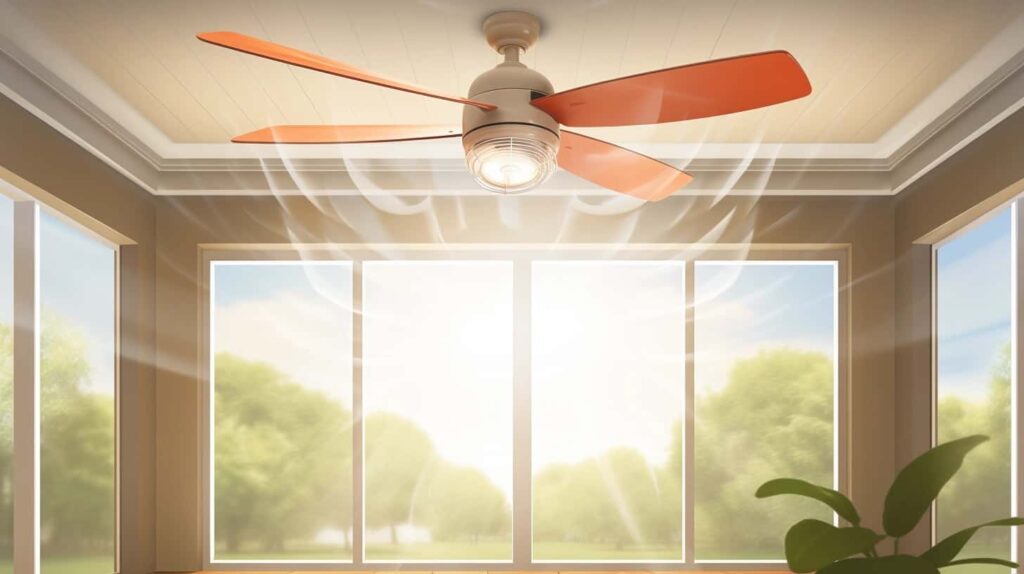
Motor Power
When considering a ceiling fan for a garage, it’s important to evaluate the motor power. The optimal motor size is crucial for efficient airflow and proper circulation in the space.
Additionally, power efficiency is a key factor to consider in order to minimize energy consumption and reduce electricity costs.
Lastly, noise level is an important consideration as a loud fan can be distracting and disruptive in a working environment.
Optimal Motor Size
To optimize the performance of a ceiling fan in the garage, it’s crucial to select the appropriate motor size, considering factors such as the size of the space and desired airflow. The motor size determines the power and efficiency of the fan, ensuring that it can effectively circulate air and maintain a comfortable environment.
When choosing the optimal motor size for your garage ceiling fan, consider the following:
- Blade Material: The material of the fan blades can impact the overall performance. Opt for blades made from durable materials such as metal or ABS plastic, which are known for their strength and ability to withstand harsh garage conditions.
- Power Efficiency: Look for a motor with high power efficiency to ensure that the fan operates effectively without consuming excessive energy. This won’t only save on electricity costs but also contribute to a more sustainable and eco-friendly garage.
- Airflow Capacity: Determine the desired airflow capacity based on the size of your garage. Larger garages may require a fan with a more powerful motor to effectively circulate air and keep the space cool.
Power Efficiency
Considering the importance of power efficiency in selecting the optimal motor size for a garage ceiling fan, it’s essential to focus on maximizing energy effectiveness while maintaining effective airflow.
When it comes to power consumption, it’s crucial to choose a motor that offers energy savings without compromising on performance. A more powerful motor may consume more energy, but it can also generate stronger airflow. On the other hand, a less powerful motor may consume less power but may not provide sufficient airflow.
Therefore, striking a balance between power consumption and performance is key. By selecting a fan with the right motor power, you can ensure optimal energy savings while still enjoying a comfortable and well-ventilated garage.
Noise Level
When it comes to the noise level of a garage ceiling fan’s motor power, there are several key factors to consider. Here are three important aspects that can affect the quiet operation of the fan:
- Motor Power: The power rating of the motor can directly impact the noise level. Higher power motors tend to produce more noise than lower power ones.
- Fan Blade Design: The design of the fan blades plays a crucial role in noise reduction. Specially designed blades can help in reducing turbulence and air resistance, resulting in quieter operation.
- Noise Reduction Techniques: Manufacturers employ various noise reduction techniques to minimize the noise level of garage ceiling fans. These techniques may include the use of sound-absorbing materials, vibration isolation mounts, and advanced motor technologies.
Mounting Options
One possible method for mounting a ceiling fan in a garage involves securing it to a sturdy beam or joist using a heavy-duty mounting bracket. This option ensures stability and durability, which is essential in a garage setting. When considering the mounting height, it’s crucial to take into account the ceiling height to ensure proper airflow. For optimal performance, the fan blades should be positioned at least 8 to 9 feet above the floor. This allows for efficient air circulation and prevents any potential hazards.
Another important factor to consider is the use of a remote control. Many garage ceiling fans come with remote controls, allowing for easy operation and convenience. With a remote control, you can adjust the fan speed, direction, and even turn the fan on or off without having to physically reach the fan itself. This feature is especially useful in a garage setting, where the fan may be mounted at a higher height.
Control Options
A practical option for controlling a garage ceiling fan is to utilize a wall-mounted control panel. This type of control option allows for easy access and operation of the fan’s speed and direction settings. Additionally, it can provide convenient control over the fan’s lighting features, allowing you to adjust the brightness or turn the lights on and off as needed.
However, if you prefer a more versatile and flexible control option, you may consider using a remote control for your garage ceiling fan. With a remote control, you can conveniently operate the fan and its lighting from anywhere within the garage. This can be especially useful if you’re working on a project and need to adjust the fan or lighting without having to stop what you’re doing.
When choosing a control option for your garage ceiling fan, it’s important to consider your specific needs and preferences. Some people may prefer the simplicity and convenience of a wall-mounted control panel, while others may prioritize the flexibility and remote operation offered by a remote control.
Whichever option you choose, make sure it aligns with your requirements for lighting control and remote control capabilities.
Lighting Features
To enhance the functionality of your garage ceiling fan, it’s important to consider the various lighting options available. A well-lit garage is essential for tasks such as working on vehicles, woodworking, or general storage purposes. When choosing a ceiling fan for your garage, look for models that offer energy-saving features to help reduce electricity consumption and lower your energy bills.
One popular lighting feature available in garage ceiling fans is the inclusion of built-in LED lights. LED lights are highly efficient and have a long lifespan, making them an excellent choice for those who want to save on energy costs. These lights provide bright illumination, ensuring that your workspace is adequately lit.
Another lighting option to consider is the ability to adjust the brightness level. Some garage ceiling fans offer dimmable lights, allowing you to customize the lighting to suit your specific needs. This feature is particularly useful when working on intricate projects that require focused lighting or when you want to create a more relaxed atmosphere in your garage.
Additionally, some ceiling fans for garages come with motion sensor lights. These lights automatically turn on when they detect movement in the garage, providing convenience and added security. They’re especially useful when entering or leaving the garage at night.
When selecting a garage ceiling fan, carefully consider the lighting features available to ensure that you create a well-lit and energy-efficient workspace.
Durability and Weather Resistance
When it comes to a ceiling fan for the garage, durability and weather resistance are essential.
Our ceiling fans are built with a strong and durable design that can withstand the demands of a garage environment.
They’re also weatherproof, meaning they can handle exposure to moisture, humidity, and extreme temperatures without compromising their performance or longevity.
Strong and Durable
The ceiling fan for the garage boasts exceptional strength and durability, making it a reliable choice for withstanding harsh weather conditions.
When looking for a strong and durable ceiling fan, consider the following factors:
- Motor Power: Opt for a ceiling fan with a powerful motor, as it ensures reliable performance and longevity even in challenging conditions. Look for brands like Hunter and Casablanca, known for their robust motors.
- Construction Materials: Choose a fan made from high-quality materials like stainless steel or aluminum, which are resistant to rust and corrosion. Brands like Craftmade and Emerson offer durable options that can withstand various weather conditions.
- Weather Resistance Features: Look for features like sealed motors, weather-resistant blades, and corrosion-resistant finishes. These ensure that the fan can withstand exposure to moisture, dust, and extreme temperatures.
Weatherproof Design
Continuing our exploration of the ceiling fan’s durability and weather resistance, let’s now focus on its weatherproof design.
When it comes to ceiling fan installation in a garage, it’s crucial to choose a fan that can withstand harsh weather conditions. Thankfully, there are several weatherproof fan options available in the market.
These fans are specifically designed to resist moisture, dust, and extreme temperature fluctuations, ensuring their longevity and performance in outdoor spaces like garages. Weatherproof ceiling fans feature sealed motors and blades made from durable materials such as ABS plastic or weather-resistant metals like stainless steel or aluminum.
Additionally, they often come with a protective coating or finish that enhances their resistance to corrosion and damage caused by exposure to the elements.
Investing in a weatherproof ceiling fan for your garage will ensure a reliable and long-lasting solution for your cooling needs.
Style and Design
With a wide range of options available, selecting the right style and design for your garage ceiling fan becomes essential. The style and design of your garage ceiling fan not only affects its functionality but also enhances the overall aesthetic appeal of your garage.
Here are three important factors to consider when choosing the style and design of your garage ceiling fan:
- Blade Design: Opt for a fan with blades that are specifically designed to move air efficiently in a garage. Look for blades that are wider and have a steeper pitch to maximize airflow and circulation.
- Finish and Color: Consider the overall look and feel of your garage when selecting the finish and color of your ceiling fan. Choose a finish that complements the existing decor and color scheme. Popular finishes for garage ceiling fans include brushed nickel, matte black, and oil-rubbed bronze.
- Lighting Options: If your garage lacks sufficient lighting, consider a ceiling fan with built-in lighting fixtures. This won’t only provide ample illumination but also save space by eliminating the need for separate light fixtures.
Budget Considerations
Considering the financial aspect is crucial when selecting the right style and design for your garage ceiling fan. Budget considerations play a significant role in determining the most suitable option for your needs. Fortunately, there are energy-saving options and cost-effective solutions available in the market.
When it comes to energy-saving options, it’s essential to look for ceiling fans that are equipped with efficient motors. These motors are designed to consume less electricity while providing optimal airflow. Look for fans that have an Energy Star rating, as they meet strict energy efficiency guidelines set by the Environmental Protection Agency (EPA). Additionally, consider fans with built-in LED light fixtures, as they consume less energy compared to traditional incandescent bulbs.
In terms of cost-effective solutions, it’s crucial to find fans that offer durability and longevity. Opt for fans made from high-quality materials that can withstand the harsh conditions often found in garages, such as heat, humidity, and dust. Additionally, look for fans that come with warranties to ensure protection and peace of mind.
Installation Process
To begin the installation process, we’ll first gather all the necessary tools and materials.
Here are the steps to follow for a successful ceiling fan installation in your garage:
- Prepare the area: Before starting the installation, ensure that the garage is well-ventilated. Proper garage ventilation is essential to prevent stale air and maintain a comfortable working environment. Open windows or install additional vents if needed.
- Turn off the power: Locate the circuit breaker that controls the garage’s electrical supply and switch it off. This step is crucial for safety during the installation process.
- Follow the instructions: Read the manufacturer’s instructions carefully before beginning the installation. Each fan may have specific requirements and guidelines that need to be followed for proper installation and optimal performance.
Maintenance and Cleaning Tips
Regular maintenance and cleaning of your garage ceiling fan is essential to ensure its optimal performance and longevity. By following these maintenance tips and cleaning techniques, you can keep your fan in excellent condition.
Firstly, it’s important to regularly inspect your ceiling fan for any signs of wear or damage. Check the blades, motor, and mounting brackets for any loose or broken parts. Tighten any loose screws or bolts and replace any damaged components promptly.
Next, make sure to clean your ceiling fan regularly to prevent the buildup of dust and dirt. Use a soft cloth or brush to gently wipe down the blades and motor housing. Avoid using harsh chemicals or abrasive materials, as they can damage the fan’s finish.
To deep clean your fan, you can remove the blades and wash them with mild soap and water. Make sure to dry them thoroughly before reattaching them to the fan. Additionally, clean the motor housing and other parts using a vacuum cleaner or compressed air to remove any debris.
Frequently Asked Questions
Can I Install a Ceiling Fan in My Garage if It Has Low Ceilings?
We can install a ceiling fan in our garage even if it has low ceilings. However, we should consider using low profile ceiling fans specifically designed for spaces with limited overhead clearance. These fans are designed to be mounted flush against the ceiling, maximizing headroom.
If low profile fans aren’t suitable, we can explore alternative cooling options such as wall-mounted fans or portable air conditioning units. It’s important to ensure proper ventilation and airflow in the garage to maintain a comfortable working environment.
How Do I Determine the Airflow Capacity Needed for My Garage?
When determining the airflow capacity needed for your garage, it’s crucial to consider the size of the space. A larger garage will require a ceiling fan with a higher airflow capacity to effectively circulate air and maintain a comfortable environment.
Are There Any Energy-Efficient Ceiling Fans Specifically Designed for Garages?
Energy efficient options for ceiling fan installation in garages are available. These fans are specifically designed to consume less electricity while providing adequate airflow. By choosing an energy-efficient ceiling fan, you can reduce your energy consumption and save on utility bills.
Look for fans with high efficiency motors and energy-saving features such as LED lights and adjustable speed settings. Additionally, consider the size and design of the fan to ensure it’s suitable for your garage space.
How Can I Reduce Noise Levels From a Ceiling Fan in My Garage?
To reduce noise levels from a ceiling fan in our garage, we need to choose the right fan. Look for fans with noise reduction features like aerodynamic blades and a quiet motor. Additionally, consider fans with a low noise level rating, measured in decibels (dB).
Installing rubber isolation mounts or using a fan with a sound-absorbing housing can further minimize noise.
Proper maintenance, such as tightening loose parts and lubricating the motor, can also help reduce noise.
Are There Any Specific Blade Materials Recommended for Garage Ceiling Fans to Withstand High Humidity Levels?
When considering blade material options for garage ceiling fans, it’s important to choose materials that can withstand high humidity levels. Some recommended blade materials include ABS plastic, stainless steel, and aluminum. These materials are resistant to moisture and are less likely to warp or corrode.
Additionally, regular maintenance is crucial to ensure longevity and performance. Keep the blades clean and free from dust and debris, and lubricate the motor and moving parts as needed.
What Type of Ceiling Fan is Best for a Garage with a Light Fixture?
When choosing a ceiling fan for a garage with a light fixture, consider the ceiling fan light wire types available. Look for a fan that is compatible with the existing wiring in your garage. Some popular ceiling fan light wire types include standard, low-profile, and dual-mount.
Conclusion
In conclusion, when choosing a ceiling fan for your garage, it’s important to consider factors such as:
- size
- airflow capacity
- energy efficiency
- noise level
- blade material
- style and design
- budget considerations
- installation process
- maintenance and cleaning tips
By taking all of these factors into account, you can ensure that you select the right ceiling fan that meets your needs and enhances the comfort of your garage space.
- About the Author
- Latest Posts
Introducing Ron, the home decor aficionado at ByRetreat, whose passion for creating beautiful and inviting spaces is at the heart of his work. With his deep knowledge of home decor and his innate sense of style, Ron brings a wealth of expertise and a keen eye for detail to the ByRetreat team.
Ron’s love for home decor goes beyond aesthetics; he understands that our surroundings play a significant role in our overall well-being and productivity. With this in mind, Ron is dedicated to transforming remote workspaces into havens of comfort, functionality, and beauty.
Garage Door Opener
Finding the Ideal Garage Door Opener Outlet Location
Get ready to discover the crucial factors determining the perfect placement for your garage door opener outlet.

When determining the best spot for a garage door opener socket, think of it as finding the missing piece to make your garage convenient and functional.
The placement of this outlet can significantly impact the ease of use and safety of your garage door opener system. So, where should it be positioned for optimal performance?
Let's explore the key factors that come into play to ensure a seamless experience with your garage door opener.
Key Takeaways
- Place the outlet around 9 feet above the door for optimal accessibility and functionality.
- Position the outlet slightly off-center to avoid interference with future insulation and maintenance.
- Ensure safety by locating the receptacle 3 feet back and 10 feet from the outside wall.
- Consult with professionals to guarantee proper placement and enhance usability.
Importance of Outlet Placement
Why is the placement of the outlet for your garage door opener crucial for optimal functionality and safety?
When it comes to the garage door opener, the electrical outlet placement plays a significant role in ensuring smooth operation and safety. By strategically locating the outlet around 9 feet above the door, slightly off-center, accessibility is enhanced without impeding future insulation or drywall modifications. This positioning also minimizes the risk of interference with the garage door opener's mechanisms, promoting seamless functionality.
Moreover, considering factors like ease of access, safety, and compliance with electrical regulations is essential for a secure and efficient garage door opener setup. Therefore, choosing the right spot for the outlet is paramount to guaranteeing the proper functioning and safety of your garage door opener.
It's not just about convenience; it's about ensuring that your garage door opener operates optimally while meeting essential safety standards and regulatory requirements.
Factors Affecting Outlet Location

Considering the layout and structure of your garage, several key factors influence the optimal placement of the outlet for your garage door opener. The door height plays a crucial role, with the ideal outlet location typically around 9 feet above the door for convenient access.
It's essential to position the outlet slightly to the side to avoid interference with future insulation and drywall work. Communicating with builders before installation can ensure the proper placement and prevent common mistakes that might arise.
Be cautious not to place the receptacle too far from the door as this could lead to issues with the opener cord reaching comfortably. Ensuring that the outlet location allows for smooth operation and easy maintenance is crucial for long-term convenience.
Safety Considerations for Outlet Placement
For optimal safety and convenience in outlet placement for your garage door opener, it's essential to position the receptacle 3 feet back from the end of the open garage door and approximately 10 feet from the outside wall. Placing the outlet in this specific location helps prevent any potential hazards that could arise from the door mechanisms or the opener's cord. By ensuring the receptacle is behind the opener, you maintain a clear pathway when the door is fully open, decreasing the risk of tripping or entanglement.
To further enhance safety, it's crucial to confirm that the cord length of the opener, typically between 3 to 4 feet, comfortably reaches the receptacle without any stretching or strain. If needed, use lumber to frame out a lower place to secure the cord of the opener to the receptacle adequately. Additionally, prioritize installing a Ground Fault Circuit Interrupter (GFCI) protected receptacle to add an extra layer of safety measures to your garage.
Convenience and Accessibility of Outlets

To ensure optimal convenience and accessibility for your garage door opener outlet, positioning it approximately 9 feet above the door allows for easy access during operation. This placement ensures that the outlet is within reach of the opener cord, reducing the risk of any operational issues. Additionally, consider situating the outlet slightly off-center to accommodate future insulation and drywall work, providing flexibility for any renovations.
When communicating with builders about the placement of the garage door opener outlet, make sure to convey the importance of having it positioned at the right height and distance from the door. Common mistakes, such as placing the receptacle too far from the door, can hinder optimal accessibility and convenience. By discussing the outlet location with builders beforehand, you can ensure that it is installed in a way that meets your needs and maximizes usability.
To illustrate further, here is a table outlining the key considerations for positioning your garage door opener outlet:
| Consideration | Description |
|---|---|
| Height Above Door | Approximately 9 feet for easy access during operation. |
| Distance from Opener Cord | Within reach to prevent operational issues. |
| Off-Center Placement | Slightly off-center to accommodate future insulation and drywall work. |
| Communication with Builders | Discuss with builders to determine the best outlet placement before installation. |
| Avoiding Common Mistakes | Ensure the receptacle is not placed too far from the door for optimal accessibility. |
Tips for Optimal Garage Door Opener Outlet Location
When determining the ideal location for your garage door opener outlet, prioritize accessibility and functionality by placing it at a height of around 9 feet above the door. This placement ensures easy reach and connection to the opener cord, facilitating seamless operation.
To optimize your garage door opener outlet location, consider the following tips:
- Positioning: Place the outlet slightly to the side to avoid interference with future insulation and drywall work.
- Consultation: Communicate with builders or professionals before installation to ensure proper placement and avoid common mistakes.
- Reachability: Avoid placing the receptacle too far from the door to prevent issues with the opener cord reaching the power source.
- Functionality: Ensure the outlet location allows for easy access and connection to maintain a smooth and efficient operation of your garage door opener.
Frequently Asked Questions
Where Should a Garage Door Opener Outlet Be Placed?
We recommend placing a garage door opener outlet near the ceiling, around 9 feet above the door for easy access. Positioning it slightly to the side can prevent interference and future issues with insulation or drywall.
Opt for a location a few feet above the door height and off-center for practical accessibility. Avoid surface mounting and ensure it's within reach of the opener cord.
Consult professionals for proper placement to avoid common mistakes.
Where Should Outlets Be Placed in a Garage?
When outfitting a garage with outlets, strategic placement is key. Consider functionality and convenience. Ensure outlets are accessible and comply with safety standards to avoid interference with garage door openers.
Optimal positioning is crucial for smooth operation. By placing outlets thoughtfully, we guarantee efficiency and ease of access. Properly spaced outlets contribute to a well-organized, functional workspace.
Take care in positioning outlets for a seamless garage experience.
Can the Garage Door Opener Be on Same Circuit as Garage Receptacles?
Yes, the garage door opener can be on the same circuit as the garage receptacles. This setup is convenient for installation and operation, simplifying wiring and electrical planning.
It's a common practice in residential settings to share the circuit between the garage door opener and receptacles. However, it's crucial to consult with an electrician to ensure the circuit can handle the combined load of both devices effectively.
How Do I Program My Garage Door Opener Outlet?
We've programmed many garage door opener outlets! Locate the 'Learn' button on the unit. Press and release it, then quickly hit the remote's button to program it.
Wait for the light to flash, showing successful programming. Test the remote for proper operation.
Always follow the manufacturer's instructions for specific steps. It's as easy as that to program your garage door opener outlet.
Conclusion
In conclusion, finding the ideal location for your garage door opener outlet is like finding the perfect key for a locked door – it unlocks convenience and safety.
By considering factors such as placement, safety measures, and accessibility, you can ensure smooth operation and peace of mind.
Remember, consulting with a professional and following best practices can guarantee a seamless experience every time you open your garage door.
- About the Author
- Latest Posts
Introducing Ron, the home decor aficionado at ByRetreat, whose passion for creating beautiful and inviting spaces is at the heart of his work. With his deep knowledge of home decor and his innate sense of style, Ron brings a wealth of expertise and a keen eye for detail to the ByRetreat team.
Ron’s love for home decor goes beyond aesthetics; he understands that our surroundings play a significant role in our overall well-being and productivity. With this in mind, Ron is dedicated to transforming remote workspaces into havens of comfort, functionality, and beauty.

Are you prepared to elevate your dental health? Check out our 12 tips for utilizing Bluetooth dental health gadgets!
These cutting-edge devices combine the power of technology with the importance of oral hygiene. We, as a team of experts, have compiled this comprehensive guide to help you master the world of Bluetooth dental tools.
From choosing the right gadget to maximizing its effectiveness, we’ve got you covered. Say goodbye to traditional dental care methods and embrace the future of oral health.
With our tips, you’ll be able to seamlessly integrate Bluetooth dental gadgets into your daily routine and enhance communication with your dentist. Get ready to achieve the smile of your dreams with the help of these innovative devices.
Key Takeaways
- Improved oral hygiene
- Real-time feedback and guidance
- Personalized recommendations for optimal brushing technique
- Enhanced portability for on-the-go use
Benefits of Bluetooth Dental Health Gadgets
The benefits of Bluetooth dental health gadgets include improved oral hygiene and enhanced monitoring of dental health. These gadgets are designed to help individuals in improving their brushing techniques and maintaining good oral health. By connecting to a smartphone or a tablet, Bluetooth dental health gadgets provide real-time feedback and guidance, ensuring that users are brushing their teeth effectively.
One of the main advantages of these gadgets is the ability to improve brushing techniques. Many people are unaware of the correct way to brush their teeth, leading to ineffective cleaning and potential oral health issues. Bluetooth dental health gadgets can track the movement and pressure applied during brushing, offering personalized recommendations for optimal brushing technique. This helps users to develop better brushing habits and achieve more thorough cleaning.
Another significant benefit is the remote dental monitoring feature offered by these gadgets. Dental health professionals can remotely monitor the brushing habits of their patients through a connected app. This allows for personalized advice and recommendations to be provided, ensuring that patients are maintaining good oral hygiene practices between dental visits.
How to Choose the Right Bluetooth Dental Tool
When choosing a Bluetooth dental tool, there are two important factors to consider: compatibility with your devices and ease of use.
It’s crucial to ensure that the tool you choose is compatible with your smartphone or other devices, so that you can easily connect and use it.
Additionally, opting for a tool that’s user-friendly and easy to navigate will help maximize its effectiveness and make your dental routine more efficient.
Compatibility With Devices
We found that researching the compatibility of Bluetooth dental tools with our devices was crucial in selecting the right tool for our dental health needs.
Bluetooth compatibility is an essential factor to consider when choosing a dental gadget, as it ensures seamless communication between the tool and our devices. It allows us to track our dental health progress, receive real-time feedback, and access personalized recommendations for improving our oral care routine.

However, it’s important to note that compatibility issues may arise, leading to troubleshooting problems. To avoid such issues, it’s recommended to check the compatibility requirements of the dental tool with our devices before making a purchase. This will help us ensure a smooth and hassle-free experience with our Bluetooth dental health gadget.
Moving forward, let’s explore the next important aspect of these tools – their ease of use.
Ease of Use
To ensure a user-friendly experience, it’s important to consider the ease of use when selecting the right Bluetooth dental tool for our needs.
When it comes to improving accessibility and usability, choosing a dental tool with a user-friendly design is crucial. Look for devices that have intuitive interfaces and easy-to-use controls. Consider tools that offer clear and concise instructions, making it easy for users to understand and operate them effectively.
Additionally, opt for devices with ergonomic designs that are comfortable to hold and use for extended periods. This will help minimize user fatigue and increase overall satisfaction with the tool.
Understanding the Importance of Bluetooth Connectivity
Understanding the importance of Bluetooth connectivity is crucial when it comes to dental health gadgets. By utilizing Bluetooth technology, these devices offer enhanced dental care by providing real-time data and personalized feedback.
This wireless convenience allows for easy usage and seamless integration with smartphones and other devices, making it a convenient and user-friendly option for monitoring and tracking oral health.
Enhanced Dental Care
Bluetooth connectivity is crucial for improving dental care through the use of innovative gadgets. By integrating wireless technology into dental health devices, we can enhance oral hygiene practices and ensure better dental care.
The benefits of wireless technology in dental gadgets are manifold. Firstly, it allows for real-time monitoring and tracking of oral health, providing accurate data that can be analyzed by dental professionals.
Secondly, Bluetooth connectivity enables seamless communication between devices, allowing for personalized feedback and guidance on oral hygiene routines. This promotes a more effective and targeted approach to dental care.
Additionally, wireless technology facilitates the integration of dental gadgets with smartphone applications, making it easier for users to track and manage their oral health.
Wireless Convenience Benefits
How can Bluetooth connectivity enhance our dental health gadgets?
Bluetooth connectivity offers a range of wireless connectivity advantages that greatly contribute to the convenience of Bluetooth gadgets. Here are five key benefits of Bluetooth connectivity for dental health gadgets:
- Seamless syncing: Bluetooth allows for effortless synchronization between your dental health gadget and your smartphone or other devices, ensuring that your data is always up to date.
- Hands-free operation: With Bluetooth connectivity, you can control your dental health gadget without the need for physical buttons or touchscreens, allowing for a more hygienic and convenient experience.
- Remote monitoring: Bluetooth-enabled dental health gadgets can transmit data in real-time to your smartphone or computer, allowing you to track your oral health progress even when you’re not near your gadget.
- Enhanced portability: Bluetooth gadgets are typically compact and lightweight, making them easy to carry and use on the go.
- Multi-device compatibility: Bluetooth connectivity enables your dental health gadget to connect with multiple devices simultaneously, providing flexibility and convenience for users with multiple devices.
With these wireless convenience benefits, Bluetooth connectivity significantly enhances the overall user experience of dental health gadgets.
Improved Data Tracking
We have seen a significant improvement in data tracking with the introduction of Bluetooth connectivity in dental health gadgets. This technology has revolutionized the way we monitor our oral health. With improved accuracy and real-time monitoring, Bluetooth dental gadgets allow us to track our dental hygiene habits more effectively.
By connecting these gadgets to our smartphones or other devices, we can easily access and analyze the data collected from our brushing habits, gum health, and more. This level of data tracking provides valuable insights into our oral health, helping us identify areas for improvement and track progress over time.
Now, let’s explore the top features to look for in Bluetooth dental gadgets to make the most of this advanced data tracking capability.
Top Features to Look for in Bluetooth Dental Gadgets
When choosing Bluetooth dental health gadgets, it’s important to consider the top features that will enhance our oral care routine. Here are some key features to look for:
- Bluetooth Connectivity: Bluetooth-enabled dental gadgets offer the benefits of wireless connectivity, allowing us to easily sync our device with our smartphones or tablets. This enables us to access real-time data and receive notifications for reminders and updates.
- Data Tracking: The importance of data tracking can’t be overstated. Look for gadgets that can track and store essential dental health information such as brushing time, pressure applied, and areas of the mouth that need more attention. This data can provide valuable insights into our brushing habits and help us make improvements.
- Interactive Apps: Choose gadgets that come with interactive mobile applications. These apps provide personalized guidance, oral care tips, and progress tracking, making our oral care routine more engaging and effective.
- Timers and Reminders: Look for gadgets that have built-in timers and reminders to ensure we brush for the recommended two minutes and replace our brush heads regularly. These features help us maintain good oral hygiene habits.
- Compatibility with Multiple Users: If sharing the gadget with family members, opt for devices that can track and store data for multiple users. This ensures that each user can have their own personalized oral care routine.
Considering these top features will help us choose Bluetooth dental health gadgets that optimize our oral care routine.
Now, let’s explore some tips for using these gadgets effectively.
Tips for Using Bluetooth Dental Health Gadgets Effectively
To effectively utilize Bluetooth dental health gadgets, it’s crucial to ensure proper syncing and calibration of the device. This ensures accurate and reliable data collection, allowing you to track and improve your dental habits effectively.
To maximize device performance, start by syncing your gadget with a compatible mobile app or software. Follow the manufacturer’s instructions carefully to ensure a successful connection.
Once synced, calibrate the device according to your specific dental needs. This may involve setting personalized targets for brushing time, pressure, or technique.
Regularly check for firmware updates to ensure your device is running the latest software, which can enhance its performance and functionality.
It’s also important to clean and maintain your gadget regularly to avoid any performance issues. Refer to the manufacturer’s guidelines for cleaning instructions and best practices.
Common Misconceptions About Bluetooth Dental Tools
There are several common misconceptions about Bluetooth dental tools that we need to address.
First, it’s important to understand that Bluetooth technology can actually improve oral hygiene by allowing for seamless communication between dental devices and smartphone apps.
Secondly, wireless technology enhances dental care by providing real-time data and personalized feedback to users.
Lastly, we’ll debunk some of the myths surrounding dental gadgets to ensure that users have accurate information about their benefits and limitations.
Bluetooth Improves Oral Hygiene
Although there are common misconceptions about Bluetooth dental tools, we’ve found that they significantly improve oral hygiene. Here are five reasons why Bluetooth dental tools are beneficial for your oral health:
- Improved brushing techniques: Bluetooth dental tools provide real-time feedback on your brushing technique, helping you achieve a more thorough clean.
- Oral health tracking: These tools can track your brushing habits and provide data on your oral health, allowing you to make informed decisions about your dental care routine.
- Timely reminders: Bluetooth dental tools can send reminders to brush, floss, and rinse, ensuring that you maintain a consistent oral hygiene routine.
- Personalized recommendations: Based on your brushing data, these tools can provide personalized recommendations for toothpaste, toothbrushes, and other oral care products.
- Motivation and accountability: Bluetooth dental tools can gamify oral hygiene, making it more enjoyable and encouraging you to maintain good oral health habits.
Wireless Technology Enhances Dental Care
We have encountered several misconceptions about Bluetooth dental tools that hinder their recognition as a valuable wireless technology for enhancing dental care.
One common misconception is that wireless toothbrushes are just a gimmick. However, these toothbrushes use Bluetooth technology to connect to a smartphone app, providing real-time feedback on brushing habits and helping users improve their oral hygiene.
Another misconception is that a Bluetooth toothpaste dispenser is unnecessary. In reality, this device ensures that the right amount of toothpaste is dispensed, reducing waste and promoting proper dental hygiene. It also helps users track their toothpaste usage, ensuring they never run out.
Myths About Dental Gadgets
Our experience with Bluetooth dental tools has revealed common misconceptions surrounding their effectiveness. Let’s debunk these myths and shed light on the benefits of using Bluetooth in dental care:
- Bluetooth dental gadgets aren’t just a fad; they provide real-time data and accurate measurements for better dental health monitoring.
- Contrary to popular belief, Bluetooth dental tools are easy to use and integrate seamlessly into your oral care routine.
- Some people think that Bluetooth dental gadgets are expensive, but they offer long-term cost savings by enabling early detection and prevention of dental issues.
- Another misconception is that Bluetooth dental tools are only for professionals. In reality, they empower individuals to take control of their oral health and make informed decisions.
- Lastly, some may worry about the security and privacy of Bluetooth dental gadgets. However, manufacturers prioritize data protection, ensuring that your information remains confidential.
Troubleshooting Common Issues With Bluetooth Dental Gadgets
Identifying and resolving common issues with Bluetooth dental gadgets can significantly improve their functionality and user experience. Troubleshooting connection issues and optimizing battery life are two key areas to focus on when encountering problems with these devices. Here are some tips to help you troubleshoot and overcome these issues:
| Common Issues | Possible Solutions |
|---|---|
| Connection drops frequently | Ensure that the Bluetooth device is within range and there are no obstructions interfering with the signal. Try reconnecting the device or resetting the Bluetooth settings. |
| Poor sound quality during calls | Check if the microphone and speaker are properly aligned. Adjust the volume settings on both the device and the dental gadget. If the problem persists, try restarting both devices. |
| Short battery life | Reduce the usage of power-intensive features such as continuous monitoring or high volume settings. Disconnect the Bluetooth connection when not in use. Consider replacing the battery if it is old or not holding a charge effectively. |
How Bluetooth Technology Enhances Dental Health Monitoring
When it comes to enhancing dental health monitoring, Bluetooth technology plays a crucial role. Bluetooth dental technology has revolutionized the way dentists and patients can monitor oral health. Here are five ways Bluetooth technology enhances dental health monitoring:
- Real-time data: Bluetooth dental devices can transmit real-time data to a connected smartphone or computer, allowing dentists to monitor patients’ oral health instantly.
- Remote monitoring: With Bluetooth dental monitoring, dentists can remotely monitor patients’ oral health without the need for in-person visits, making it more convenient for both parties.
- Continuous tracking: Bluetooth dental devices can continuously track various parameters such as brushing habits, pressure applied during brushing, and even the presence of harmful bacteria, providing a comprehensive picture of oral health.
- Personalized feedback: Bluetooth dental technology enables dentists to provide personalized feedback and recommendations based on the data gathered, helping patients improve their oral hygiene practices.
- Early detection: By monitoring oral health in real-time, Bluetooth dental monitoring devices can help dentists detect potential issues early on, allowing for prompt intervention and treatment.
Bluetooth dental technology has transformed the way we monitor dental health, providing dentists with valuable insights and patients with convenient and personalized care. With its ability to transmit real-time data, enable remote monitoring, and provide continuous tracking, Bluetooth technology is undoubtedly a game-changer in dental health monitoring.
The Future of Bluetooth-Enabled Dental Health Gadgets
As we look ahead to the future of Bluetooth-enabled dental health gadgets, it’s clear that these innovative devices will continue to revolutionize the way we monitor and maintain oral health. With ongoing advancements in technology, we can expect exciting developments in the field of dental health monitoring.
One potential future advancement is the integration of artificial intelligence (AI) into Bluetooth-enabled dental health gadgets. AI algorithms could analyze data collected by these devices and provide personalized recommendations for improving oral hygiene. This could help individuals optimize their dental care routines and prevent future oral health issues.
Another area of future advancement is the incorporation of augmented reality (AR) technology. AR could enhance the user experience by providing real-time visual feedback during brushing or flossing, ensuring that individuals are maintaining proper technique. This could be particularly beneficial for children or people with limited dexterity.
While the future of Bluetooth-enabled dental health gadgets appears promising, there are also potential drawbacks to consider. Privacy and security concerns may arise as these devices collect and transmit personal health data. It will be crucial for manufacturers to prioritize data protection and ensure robust security measures are in place.
Bluetooth Dental Gadgets for Children’s Oral Care
In our exploration of the future of Bluetooth-enabled dental health gadgets, we can now turn our attention to the specific application of these devices for children’s oral care. Bluetooth dental gadgets aren’t only designed for adults but also cater to the needs of children, ensuring their oral health is taken care of in a fun and engaging way.
Here are some key features of Bluetooth dental gadgets for children:
- Interactive brushing experience: These gadgets use Bluetooth toothbrush technology to connect to a mobile app, transforming brushing into a game or adventure, making it more enjoyable for children.
- Tracking and monitoring: Parents can track their child’s brushing habits and receive real-time updates on their progress through the app. This helps in ensuring that children brush for the recommended duration and reach all areas of their mouth.
- Rewards and incentives: Some Bluetooth dental gadgets have built-in reward systems, where children earn points or badges for brushing correctly. This motivates them to maintain good oral hygiene habits.
- Educational content: The mobile apps accompanying these gadgets often include educational videos and tips, teaching children about the importance of oral hygiene and proper brushing techniques.
- Parental control: Parents can have control over the settings and features of the Bluetooth dental gadgets, ensuring that the devices are safe and appropriate for their children’s age.
Bluetooth dental gadgets for children provide an innovative and effective way to instill good oral hygiene habits from a young age, making dental care a positive experience for children.
Integrating Bluetooth Dental Gadgets Into Your Daily Routine
To seamlessly incorporate Bluetooth dental gadgets into our daily routine, we can actively engage with their features and make oral care a priority for our whole family. Bluetooth toothbrushes, in particular, offer numerous benefits that can enhance our wellness routine.
These gadgets connect to our smartphones or other devices, allowing us to track our brushing habits and receive real-time feedback on our technique. By incorporating these gadgets into our daily routine, we can ensure that we’re brushing for the recommended two minutes and reaching all areas of our mouth effectively. Additionally, Bluetooth toothbrushes often come with built-in timers and reminders, making it easier for us to stay consistent with our oral care routine.
By involving our whole family in this process, we can create a positive and supportive environment that encourages good dental habits for everyone. Involving our children in the use of Bluetooth dental gadgets can make oral care more engaging and fun, helping them develop good oral hygiene habits from an early age.
Enhancing Communication With Your Dentist Using Bluetooth Tools
One important way to enhance communication with our dentist is by utilizing Bluetooth tools. These innovative devices can greatly improve dental appointments and facilitate remote dental consultations. Here are five ways Bluetooth tools can enhance communication with your dentist:
- Real-time communication: Bluetooth tools allow for seamless and instant communication between patients and dentists. Whether it’s sending images of your teeth or discussing concerns, Bluetooth tools enable quick and efficient communication.
- Remote consultations: With Bluetooth tools, you can have virtual consultations with your dentist without having to physically visit the dental clinic. This saves time and allows for more convenient appointments.
- Monitoring oral health: Bluetooth-enabled devices can monitor and track your oral health, providing valuable data to your dentist. This information helps them identify any potential issues and provide personalized advice during your appointments.
- Sharing dental records: Bluetooth tools make it easy to share dental records and X-rays with your dentist. This ensures that your dentist has access to accurate and up-to-date information, enabling them to provide better care.
- Treatment reminders: Bluetooth tools can send reminders for dental appointments and medication schedules. This helps ensure that you never miss an important dental visit or forget to take necessary medication.
Are Bluetooth Dental Health Gadgets Effective for Allergy Sufferers?
Bluetooth dental health gadgets may not directly impact allergy sufferers, but using a top HEPA vacuum can help eliminate allergens in the environment. Keeping the home clean with one of the top HEPA vacuums for allergy sufferers can reduce exposure to allergens and improve overall dental health.
Frequently Asked Questions
Can Bluetooth Dental Health Gadgets Be Used by Individuals With Braces or Other Orthodontic Appliances?
Bluetooth dental health gadgets can be used by individuals with braces or other orthodontic appliances, but their effectiveness may be limited. These gadgets can help monitor oral hygiene habits and provide feedback, but they may not be able to accurately track certain areas around the braces. Additionally, there’s a risk of damaging the gadgets or braces if they come into contact.
It’s important to consult with your orthodontist before using these gadgets to ensure they’re safe and appropriate for your specific situation.
Are There Any Specific Precautions or Guidelines to Follow When Using Bluetooth Dental Health Gadgets?
When using Bluetooth dental health gadgets, there are important precautions and guidelines to follow. To ensure optimal usage, it’s crucial to adhere to these recommendations.
By taking these precautions, you can maximize the benefits of these gadgets while minimizing any potential risks. Following the guidelines will help you maintain good oral hygiene and achieve better dental health.

Do Bluetooth Dental Health Gadgets Require a Separate App or Software to Function?
Bluetooth dental health gadgets don’t require a separate app or software to function. These devices utilize Bluetooth technology to connect directly to your smartphone or other compatible device.
Once connected, you can easily track and monitor your dental health using the dedicated app provided by the manufacturer. This app allows you to view real-time data, set reminders, and access personalized recommendations for improving your oral hygiene.
It’s a convenient and efficient way to take control of your dental health.
Can Bluetooth Dental Health Gadgets Be Used by Individuals With Dental Implants or Other Dental Prosthetics?
Bluetooth dental health gadgets can indeed be used by individuals with dental implants or other dental prosthetics. These gadgets have the potential to greatly improve oral hygiene by providing real-time feedback and personalized recommendations.
However, there are some advantages and disadvantages to consider. On one hand, Bluetooth dental health gadgets can help individuals with dental implants maintain proper oral care.
On the other hand, the gadgets may not be as effective in detecting plaque or other dental issues in hard-to-reach areas around the implants.
Are Bluetooth Dental Health Gadgets Compatible With All Types of Smartphones and Devices?
Bluetooth dental health gadgets are compatible with a wide range of smartphones and devices, making them versatile and convenient to use. They can also be used with non-smartphone devices, allowing more people to benefit from their features.
The benefits of using these gadgets include real-time feedback on brushing techniques, tracking of brushing habits, and reminders for regular dental check-ups. Incorporating Bluetooth technology into dental health gadgets enhances their functionality and improves oral hygiene practices.
Conclusion
In conclusion, with the help of Bluetooth dental health gadgets, achieving a dazzling smile has never been easier. These innovative tools not only provide numerous benefits and features but also enhance communication with your dentist.
So, why not dive into the world of Bluetooth dental gadgets and let them take your oral care routine to new heights? It’s like having a personal dental assistant right at your fingertips, guiding you towards a healthier, happier mouth.
Say goodbye to dental woes and hello to a brighter future!
- About the Author
- Latest Posts
Introducing Charles, the Editor in Chief at ByRetreat, whose passion for interior design and editorial excellence elevates every remote workspace to new heights. With his keen eye for detail, impeccable taste, and expertise in design, Charles brings a wealth of knowledge and creativity to the ByRetreat team.
As the Editor in Chief of a renowned lifestyle blog, Charles has honed his skills in curating captivating content and staying up-to-date with the latest trends in interior design. His deep understanding of aesthetics and the power of storytelling through design enables him to create remote workspaces that are not only visually stunning but also rich in personality and meaning.
Garage Door Opener
Programming Your Precision Garage Door Opener Remote Easily
Breeze through programming your Precision Garage Door Opener remote with a crucial tip for effortless operation – find out what it is!

Setting up your Precision Garage Door Opener remote is generally considered user-friendly. However, it is important not to overlook a crucial step that could cause problems in the future.
Understanding this key detail will not only simplify the programming process but also ensure smooth operation of your garage door.
Stay tuned to discover the essential tip that will make programming your remote a breeze.
Key Takeaways
- Clear previous opener codes by holding the Learn button for 6 seconds.
- Set a new code by pressing a random sequence of switches for enhanced security.
- Sync remotes and keypads by entering new codes within 30 seconds of pressing the Learn button.
- Test functionality of each device to ensure proper operation and troubleshoot if needed.
Clear Previous Opener Code
To reset the garage door opener code, locate and press the Learn button on the overhead motor unit for 6 seconds. This action initiates the clearing process, allowing you to remove the previous opener code from the system. If necessary, remove the lens cover to access the Learn button easily. By pressing and holding the Learn button, you ensure that the previous opener code is completely cleared. This step is crucial before proceeding to input a new code for your garage door opener remote.
Make sure to press and hold the Enter button as well, until you observe lights flashing or listen for clicks if lights aren't visible. Confirm that the previous opener code has been successfully removed before attempting to program the new remote control. By following these simple steps, you can effectively clear the previous opener code from your garage door opener system and prepare it for the setup of a new remote.
Input New Opener Code

After successfully clearing the previous opener code from your garage door opener system, the next step is to input a new code by locating the numbered switches on the back of the motor unit.
These switches are essential for setting up a secure code for your Precision Garage Door opener. To ensure optimal security, it's recommended to press a mix of switches in a random sequence.
When inputting the new code, make sure to include a combination of both top and bottom switches. Avoid using only top or bottom switches to prevent code duplication and enhance the security of your garage door opener.
Program Remote and Keypad
When programming your garage door opener remote and keypad, press the 'Learn' button on the garage door opener motor to begin the setup process efficiently.
With the remote in hand, locate the 'Learn' button on the motor unit, typically found near the hanging antenna wire. Once you press the 'Learn' button, an indicator light will illuminate, signaling that the motor is ready to learn new devices.
Quickly enter a new code on the keypad within 30 seconds to sync it with the opener. Repeat this process for each additional remote or keypad you wish to program, ensuring that each one flashes or beeps to confirm successful programming.
It's essential to test the functionality of each programmed device to guarantee they're operating correctly. If you encounter any issues during programming, consider consulting certified technicians for assistance in troubleshooting and completing the setup process seamlessly.
Test Remote Functionality

Check the garage door's response by pressing the button on the remote to verify its functionality. It's essential to ensure that the remote is working correctly to operate your garage door efficiently. Here are some steps to test the remote:
- Look for a flashing light on the motor unit to confirm the signal reception.
- Operate the garage door using the remote and check for any delays or issues in its functioning.
- Test the remote from various distances to evaluate the range of operation it provides.
- If the remote fails to work, troubleshoot by checking the battery levels and consider reprogramming if necessary.
Testing the remote's functionality is crucial to maintaining seamless access to your garage. By following these steps and troubleshooting any issues promptly, you can ensure that your garage door opener remote operates smoothly and reliably.
Contact Precision Door Support
For prompt assistance with your garage door needs, reach out to Precision Door Support at 800-DOOR-REPAIR. As a subsidiary of Foris Solutions, LLC, Precision Garage Door of Southeast Michigan offers expert help for all your garage door requirements.
Easily schedule services through the provided link to ensure prompt support for your garage door and opener issues. With certified technicians on hand, you can rely on Precision Door Support for setting changes, programming support, and any repair services you may need.
Whether you're facing difficulties with programming your garage door opener remote or require maintenance services, contacting Precision Door Support at 800-DOOR-REPAIR is the first step towards resolving your garage door concerns efficiently. Trust in the expertise of Precision Garage Door to provide you with the assistance and guidance necessary to keep your garage door functioning optimally.
Frequently Asked Questions
How Do I Program My Precision Garage Door Remote?
To program your Precision garage door remote, follow these steps:
- Locate the 'Learn' button on the opener motor.
- Press and release the 'Learn' button to enter programming mode.
- Press the desired button on your remote within 30 seconds.
- Wait for the opener's lights to flash or hear a click to confirm success.
- Test the remote to ensure it works.
This simple process ensures your remote is synced and ready to use with your garage door opener.
Why Is My Precision Garage Door Opener Remote Not Working?
We should first check the battery life and ensure there's no electronic interference affecting the signal of the Precision garage door opener remote.
If the issue persists, we must verify the correct programming by syncing it with the opener according to the manufacturer's instructions.
Inspect for physical damage that could be causing malfunctions.
If problems persist, contacting Precision Door for troubleshooting assistance is recommended to address the remote not working properly.
How Do I Reprogram My Garage Door Opener Remote?
We've got this covered!
To reprogram your garage door opener remote, simply press the 'Learn' button on the motor unit. Hold down the remote button within 30 seconds to sync it with the opener. Watch for confirmation lights or listen for clicks to confirm success. Repeat this process for any additional remotes to keep them all in sync.
Don't forget to reset keypad codes by entering a new 4-digit PIN and hitting enter.
Can You Program a Garage Remote Yourself?
Yes, we can program a garage remote ourselves.
It's a simple process that empowers us to control our garage door opener conveniently. By locating the Learn button on the motor unit and following easy steps, we can add or remove remotes as needed. DIY programming saves time and money, offering flexibility and convenience.
Conclusion
So there you have it, programming your Precision Garage Door Opener remote is as easy as pie. Just follow the simple steps, and you'll be opening and closing your garage door with ease.
It's almost too easy, you might even start to miss the days of struggling with a manual door. But hey, at least now you can impress your friends with your high-tech garage door skills.
- About the Author
- Latest Posts
Introducing Ron, the home decor aficionado at ByRetreat, whose passion for creating beautiful and inviting spaces is at the heart of his work. With his deep knowledge of home decor and his innate sense of style, Ron brings a wealth of expertise and a keen eye for detail to the ByRetreat team.
Ron’s love for home decor goes beyond aesthetics; he understands that our surroundings play a significant role in our overall well-being and productivity. With this in mind, Ron is dedicated to transforming remote workspaces into havens of comfort, functionality, and beauty.
-

 Decor1 week ago
Decor1 week agoMaximalist Decor Explained: Embrace More Style
-

 Vetted4 weeks ago
Vetted4 weeks ago15 Best Drip Irrigation Systems to Keep Your Garden Thriving
-

 Vetted2 weeks ago
Vetted2 weeks ago15 Best Foot Massagers for Neuropathy to Soothe Your Feet and Relieve Discomfort
-

 Vetted3 weeks ago
Vetted3 weeks ago15 Best Sports Laundry Detergents for Keeping Your Activewear Fresh and Clean
-

 Vetted3 weeks ago
Vetted3 weeks ago15 Best Tall Toilets for Seniors That Combine Comfort and Safety
-

 Vetted4 weeks ago
Vetted4 weeks ago15 Best Dish Scrubbers to Keep Your Kitchen Sparkling Clean
-

 Vetted19 hours ago
Vetted19 hours ago15 Best Cleaners for Fiberglass Showers to Keep Your Bathroom Sparkling Clean
-

 Decor4 weeks ago
Decor4 weeks agoWhat Is Eclectic Home Decor









